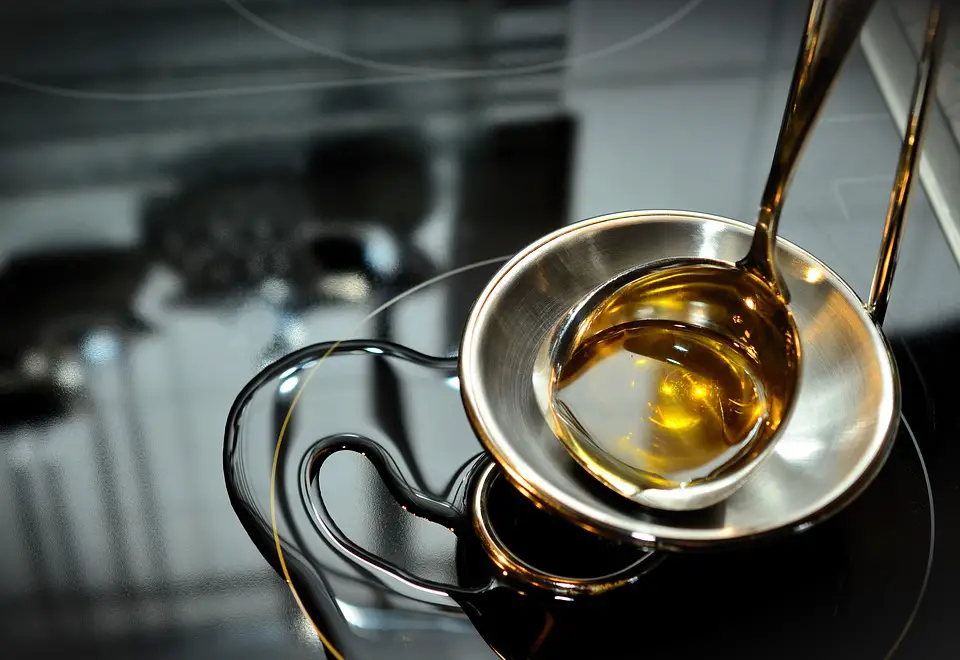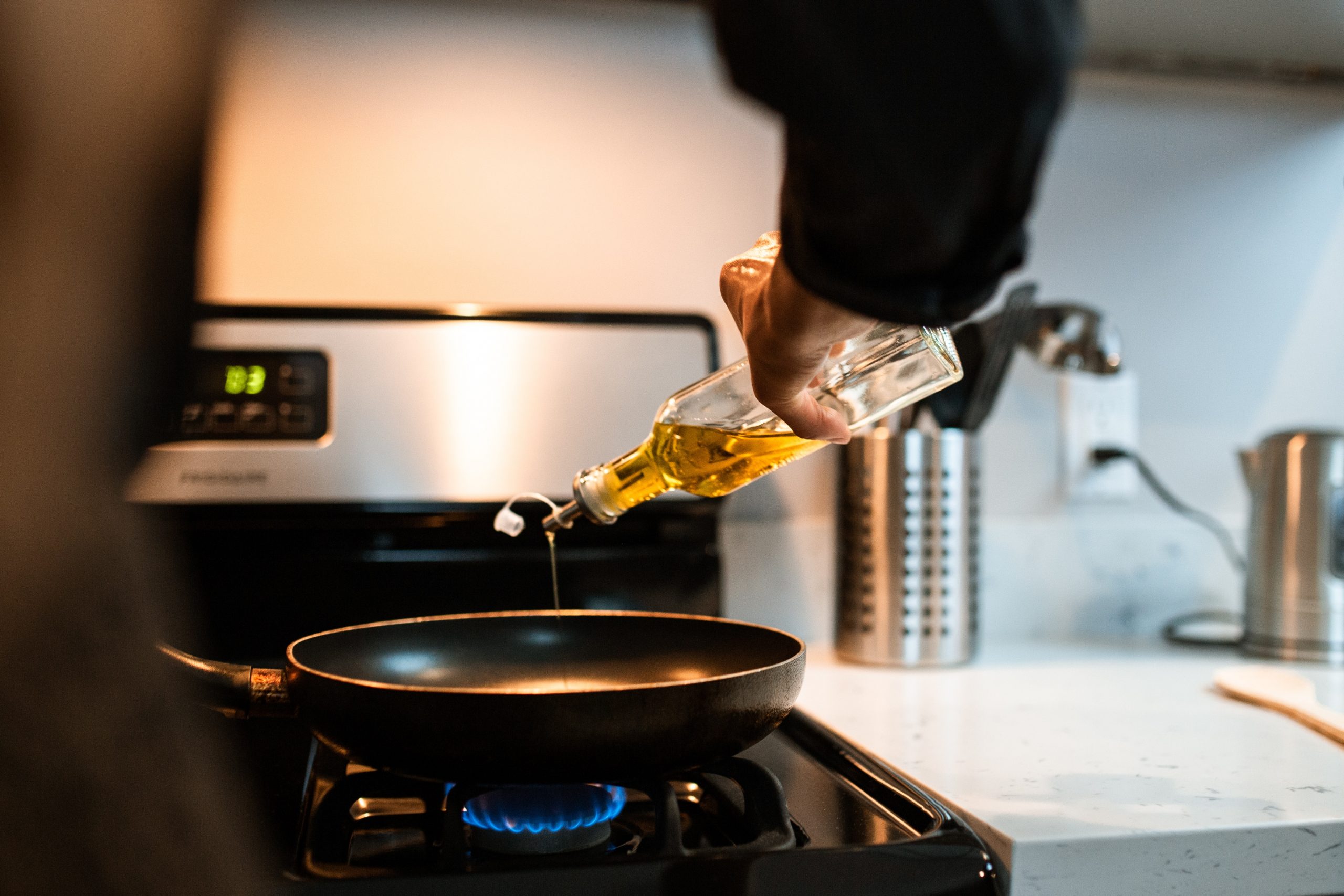Reusing cooking oil can greatly reduce food waste in your home and your grocery bill. Choose a high-quality oil with a high smoking point and sift it through cheesecloth after each use if you want to reuse your cooking oil. Used cooking oil should be kept in a sealed container in a cool, dry location.
If you are tired of throwing away used cooking oil because you can’t store it in the refrigerator, you may be surprised to learn there are ways to reuse it. Here are some ways to use your leftover vegetable oil.

What is Cooking Oil?
Cooking oil is a liquid fat made of plants, animals, or synthetic materials used in baking, frying, and other cooking processes. It may also be referred to as edible oil because it is used in cold food preparation and flavoring, including salad dressings and bread dips.
At room temperature, cooking oil is normally a liquid, although some saturated-fat oils, such as coconut oil, palm oil, and palm kernel oil, are solids.
Cooking oils come in a wide range of types, including those derived from plants like olive oil, palm oil, soybean oil, canola oil (rapeseed oil), corn oil, and peanut oil, as well as those derived from animals like butter and lard.
How to Store Used Cooking Oil?
Since exposure to air and light speeds up oil’s rate of oxidative rancidification and the production of off smells and odors, a cool, dark closet is suitable for short-term storage. However, the cooler the storage temperature, the better for long-term storage (more than a month).
We used vegetable oil to fry the chicken, then split it (after straining) among three containers and kept them in different places: a cool, dark cupboard; the refrigerator; and the freezer. We sautéed white bread bits in each sample and tasted them two months later. The oil in the freezer tasted amazingly clean, but the oil left in the cabinet had turned fishy and unpleasant, and the sample in the refrigerator was only slightly less so. Why?
Even while a lack of light is crucial, extremely cold temperatures are most efficient at delaying oxidation and the creation of peroxides, which are the cause of rancid oil’s disagreeable taste and odor. Your best bet for keeping oil fresh is to store it in a very cold, well-lit freezer.
How to Freeze Cooking Oil?
The procedure of freezing cooking oils is fairly easy. Sunflower, vegetable, canola, olive, and rice bran oil are all suitable for freezing. However, you shouldn’t freeze used cooking oil because it will quickly turn rancid.
Here are some quick instructions for freezing oil:
Step 1 of Freezing Regular Cooking Oil in Containers: Pour Into A Container Made Of Plastic
You should put your cooking oil in a plastic container.
Step 2: Give Yourself Room to Grow
To allow for expansion when the container is placed in the freezer, fill it up to three-quarters of its capacity.
Step 3: Freeze
The container should be put in the freezer.
Chunks of Regular Cooking Oil Frozen
Step 1: Fill an ice cube tray with oil.
Pour some frying oil into a silicone ice tray.
Step 2: Flash Freeze Tray
Overnight, put the tray in the freezer.
Step 3: Rearrange Cubes Into Bags After Removing Them
The following morning, take out the frozen oil cubes and put them in a freezer-safe or airtight bag.
Step 4: freeze
Place the bags in the freezer.
How to Choose the Best Cooking Oil?
Some individuals are reluctant to use additional fat in their cooking, but if you use a healthy fat-containing oil sparingly, it will improve your nutrition.
Although fat is necessary for your body and contains a high-calorie content (9 calories per gram), some forms of fat are better for you than others. Even with “healthy” fats, too much can be a problem. First, follow the instructions your doctor told you. You can find out what restrictions you should adhere to from your doctor or a trained dietician.
Always keep in mind an oil’s smoke point when cooking; this is the point at which the oil starts to smoke and emit potentially hazardous odors and free radicals. An oil’s smoke point rises the more refined it is. Furthermore, remember that each oil has a different chemical composition, so some will be better suited for sautéing, some for searing, and others for recipes requiring no heat, like salad dressings.
Any good fats and antioxidants in an oil burn or smoke with it. Additionally, the oil will create free radicals, which can be harmful and result in health issues, particularly if you use burned oil frequently. Each type of cooking oil has a unique smoke point temperature.
What are the Different Types of Cooking Oil?
Most supermarket stores carry the most often-used oils.
Canola Oil
The rapeseed plant provides the source of this ubiquitous oil. It is an excellent choice for frying, sautéing, and baking because of its neutral flavor and high smoke point. Margarine is also made with it. Canola oil has one of the lowest levels of saturated fats, but it doesn’t contain as much blood pressure-lowering omega-3 as extra-virgin olive oil. Because of this, it might be a wise decision to promote heart health. Additionally, it contains ALA, which your body uses to create important fatty acids. As a result, it’s a fantastic addition to a vegetarian diet.
Olive Oil
This aromatic, fruity-tasting oil is made from crushed olive fruit and pits and is green or yellow in hue. The smoke point of extra virgin olive oil, the least refined oil, is the lowest. The heart benefits from it as well. Refined and extra virgin oils are combined in bottles labeled “olive oil.”
Coconut Oil
The rumor about this delectable, popular oil is that it might have disease-preventing qualities, but those concerned about their blood pressure should beware: The most saturated fat is found in this oil. It’s simple to give in to temptation when something tastes delicious, but excessive saturated fat is bad for your health. Use conventional, non-tropical vegetable oils only. Canola and olive oil are preferable choices.
How Long does Cooking Oil Last?
Vegetable oils include but are not limited to, peanut, sunflower, and soybean oils. On the other hand, their shelf lifetimes are remarkably similar. Vegetable oil should be kept for at least two years, if not much longer if kept sealed and stored properly. It should also keep for at least a year after you open the bottle.
If you store vegetable oil properly, you can prevent it from going bad for a longer period, possibly even much longer.
Another thing to remember is that oil’s flavor changes over time, and you might not like those changes, especially if you wish to use the oil in a salad and it starts to change.
A few words about storing vegetable oil: remember that vegetable oil should be stored in a cold, dry atmosphere first and foremost. It is typical and a great idea to keep it in the pantry.
On the other hand, refrigerating vegetable oil is not a good idea. Storing the bottle in the pantry cabinet seems to be the best solution because keeping it out of direct sunlight is also a good idea.
When not using the oil, ensure the bottle is well sealed after you’ve opened it. Regular exposure to fresh air initiates the oxidation process, which speeds up oil degradation. As a result, the bottle won’t contain any contaminants or air.
How to Tell if Cooking Oil is Bad?
Cooking oils will ultimately go bad but not mildew or rot. The most obvious sign when cooking oil has gone bad is rancidity. Rancid oil has quite an overpowering and unpleasant smell.
Oils that have been chilled may become cloudy and slightly harder, although this does not necessarily mean something is wrong. Leave the oil open at normal temperature to return to a liquid state. Some oils, like olive oil, may include sediment when kept at lower temperatures. It should be noted that this is merely a response to cooling and does not portend deterioration.
Extra-virgin olive oil is an example of an unrefined oil that is more difficult to deal with. It may be tough for non-experts to detect rancidity because of their aromas and odors.
Therefore, advocates are trying the oil. To get the oil to room temperature, pour some into a cup and, if necessary, warm it in your hands. Take a small amount of liquid (about a teaspoon) and sip it as you would through a straw without swallowing or exhaling.
Decker suggests tasting and smelling any oil the first time you open the jar because this flavor is challenging to describe. This will help you build a baseline. When it comes to using olive oils, this strategy is favorable. If it’s rotten, the rancidity aromas and the olive oil flavor will combine to give it a bad taste.
Finally, rancid oils can get sticky, so if the container feels sticky around the spout, it’s probably best to discard it.
What are the Side Effects of Consuming Cooking Oil?
Omega-6 polyunsaturated fatty acids, biologically active lipids found in very high concentrations in vegetable oils, are toxic when consumed in excess (except olive oil or coconut oil). The tendency of polyunsaturated fats to react with oxygen can result in chain reactions that harm other structures and possibly even essential ones like DNA.
When these fatty acids accumulate in cell membranes, damaging oxidative chain reactions become more prevalent. Unsaturated fats, termed eicosanoids, which are produced by the body from omega-3 and omega-6 fatty acids and are highly poisonous, are linked to a higher risk of several ailments, including heart disease, cancer, diabetes, and obesity.
Vegetable oils frequently contain high levels of trans fats, a little-known fact.
Reference: Pre-treatment of used cooking oils for the production of green chemicals: A review
Waste lipids, on the other hand, are extremely heterogeneous and contain a wide range of contaminants that may influence possible valorization pathways. Therefore, refinery operations are required to obtain sufficient oleochemical feedstocks. The pre-treatment, purification, and refinement of waste lipids using current and proposed methods are reviewed in this paper, focusing on converting used cooking oils (UCO) into oleochemical raw materials. First, an overview of the production and supply of UCOs worldwide is given, and a few prospective valorization options are discussed.
Conclusion
When storing your used cooking oil, putting it in a plastic container with a lid is a good idea. Some cities may have a drop-off program for such materials, so check with your city’s solid waste department.
You can also compost small amounts of animal fats. However, avoiding adding hot or synthetic cooking oils to your compost heap is important. These types of oils tend to coat organic material, which can inhibit the decomposition process. Using a grease trap is another option. These prevent oil from clogging your plumbing.

